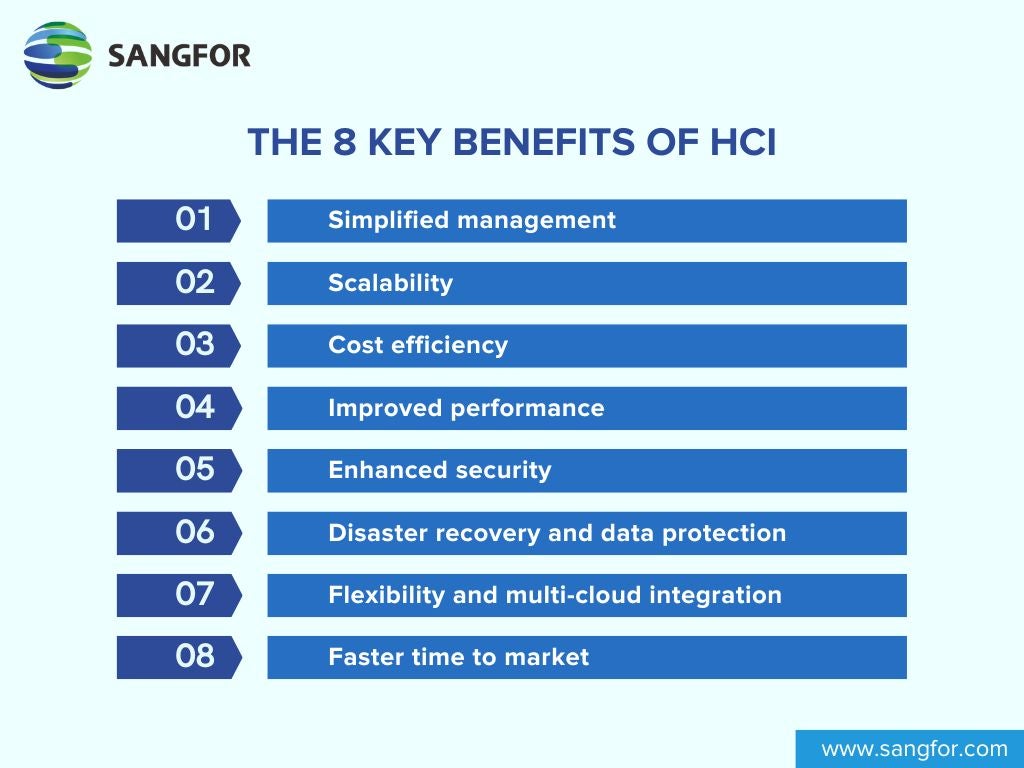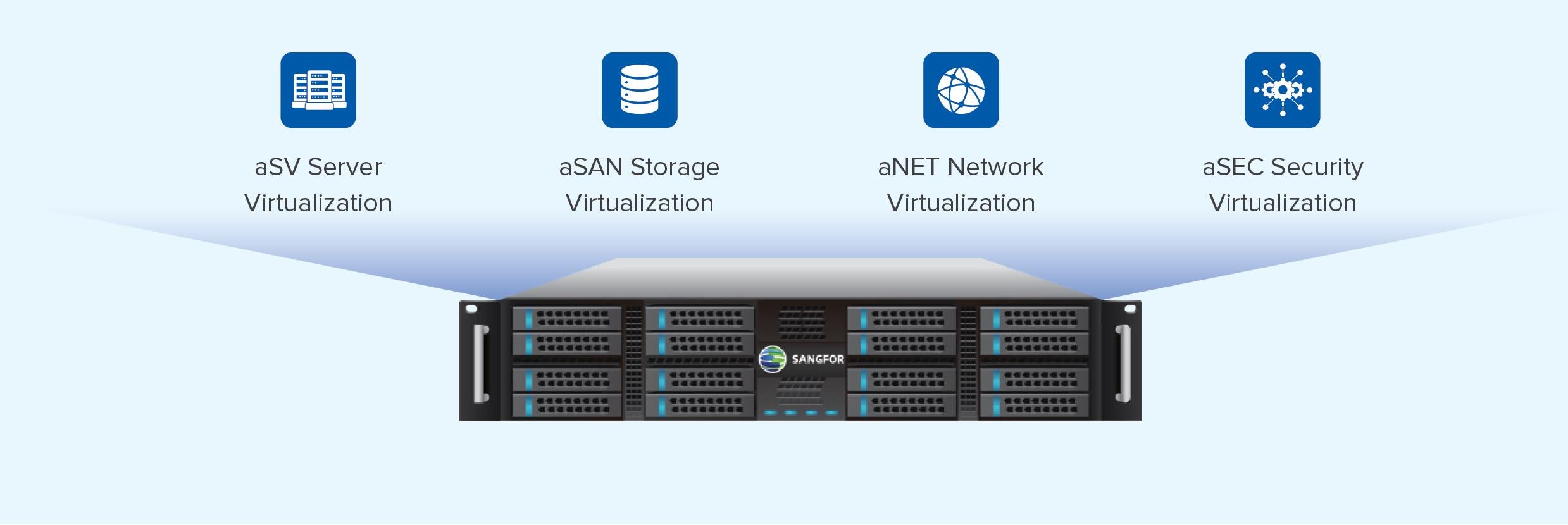Rapid technological progress in recent decades has continuously introduced new systems and solutions. Among these, Hyperconverged Infrastructure (HCI) stands out as a particularly promising technology, with its demand surging recently as more businesses recognize its benefits.
Hyperconverged Infrastructure (HCI) is becoming increasingly popular across various industries as a key technology for digital transformation. Enterprises are recognizing the benefits of HCI to modernize their IT operations and enhance agility.
Read this article to equip yourself with a deeper understanding of what is HCI, its strategic advantages and Sangfor's unique contributions to this technology sphere.
What is Hyperconverged Infrastructure (HCI)?
Hyperconverged Infrastructure (HCI) represents a significant evolution in enterprise IT, streamlining multiple core components of data center operations into a single, unified system.
By integrating components like computing, storage, networking, and management capabilities, HCI leverages software-defined technologies to enhance scalability and operational efficiency while also being cost-effective. Enterprises across various sectors are recognizing the benefits of HCI to modernize their IT operations and improve agility, positioning this technology as a cornerstone for digital transformation initiatives.
As the demand for more efficient, flexible, and budget-friendly IT solutions grows, HCI is becoming a pivotal element in reshaping the enterprise IT landscape, gradually replacing VMware and emerging as a more cost-effective and versatile alternative. This architectural shift from traditional, siloed IT infrastructures to a more integrated approach addresses the growing complexity of modern data centers and supports the rapid deployment of resources.
Understanding the Core HCI Components
Hyperconverged Infrastructure (HCI) integrates several critical elements into a cohesive system that simplifies and streamlines data center operations.
Here’s how each component plays a vital role:
- Compute virtualizes server resources, enabling efficient use of multiple virtual machines on a single server.
- Storage is managed via software-defined storage (SDS), optimizing resource use and improving redundancy.
- Networking is centrally managed, ensuring consistent performance and security.
- Management software allows seamless control of all resources from one interface, reducing operational costs and minimizing errors.
By converging these components, HCI streamlines operations, cuts costs, and increases IT agility.
Benefits of Hyperconverged Infrastructure (HCI)
Following are some of the key benefits of Hyperconverged Infrastructure:

1. Simplified management
HCI revolutionizes IT management by integrating storage, computing, and networking into a unified system. This consolidation significantly reduces the complexity traditionally associated with separate systems. With fewer vendors to coordinate and simpler software upgrades, administrative tasks are streamlined, allowing IT staff to focus on strategic initiatives rather than routine maintenance. The reduction in management layers speeds up operations and also decreases the potential for error, enhancing overall system reliability.
2. Scalability
HCI offers exceptional scalability through its modular, node-based architecture. Organizations can start with what they need and expand by simply adding more nodes, adhering to a "pay as you grow" model. This approach eliminates the costly risks of overprovisioning and underutilization. As demand increases, additional nodes can be seamlessly integrated without disrupting existing operations, ensuring that infrastructure growth is both predictable and manageable, aligning perfectly with evolving business needs.
3. Cost efficiency
One of the most compelling HCI benefits is its ability to reduce both capital expenditures (CAPEX) and operational expenditures (OPEX). By consolidating resources, organizations need fewer physical servers, which lowers hardware costs, energy consumption, and cooling requirements. Furthermore, resource consolidation can lead to significant reductions in licensing fees, as fewer servers and virtual environments are required. This streamlined approach saves money and also simplifies the entire IT environment, making it more efficient and less costly to maintain.
4. Improved performance
HCI enhances performance by integrating software-defined storage and advanced networking capabilities, which optimize data access speeds and application performance. By utilizing data locality - keeping data and compute resources in close proximity - HCI minimizes latency and accelerates workload processing. This setup ensures that resources are used as efficiently as possible, providing faster access to data and improving the overall responsiveness of applications. The result is a high-performing IT environment that can effectively meet the demands of critical business applications.
5. Enhanced security
HCI incorporates robust security measures directly into its architecture, enhancing the security framework of the infrastructure. Integrated features such as data encryption, secure virtualization, and zero-trust network segmentation fortify the defense against external and internal threats. Moreover, the centralized management inherent in HCI allows for swift, consistent updates and patches across the entire system, ensuring vulnerabilities are addressed promptly. This comprehensive and unified approach to security significantly reduces the risk of breaches and enhances compliance with industry standards.
6. Disaster recovery and data protection
HCI streamlines Disaster Recovery (DR) processes by integrating automated backups, snapshots, and seamless replication capabilities between nodes. This integration ensures that data protection is intrinsic to the infrastructure, not just an afterthought. In the event of a system failure or data loss, recovery processes are swift and less disruptive, minimizing downtime and ensuring continuity of business operations. The simplicity and efficiency of HCI's disaster recovery features provide organizations with robust tools to protect their critical data against unforeseen incidents.
7. Flexibility and multi-cloud integration
HCI provides unprecedented flexibility, supporting deployments across private, public, and hybrid cloud environments. This adaptability is essential for organizations pursuing multi-cloud strategies, allowing them to deploy workloads optimally based on cost, performance, and compliance considerations. HCI facilitates easy workload migration and integration with various cloud services, ensuring that enterprises can leverage the best attributes of each cloud model. This capability thereby enhances operational flexibility and also ensures that businesses can adapt to changing market demands and technological advancements.
8. Faster time to market
HCI significantly accelerates the deployment of new services and applications.
By consolidating infrastructure components into a pre-configured, streamlined solution, organizations can reduce the time traditionally required to provision and deploy new IT resources.
This fast deployment capability allows businesses to swiftly capitalize on market opportunities and meet customer demands. HCI's agility thereby gives companies a competitive advantage, accelerating product and service launches.
Sangfor HCI: Revolutionizing IT Infrastructure
Sangfor Technologies stands at the forefront of IT innovation, recognized globally for its advanced infrastructure solutions, security systems, and cloud computing capabilities.
With a strong commitment to research and development, Sangfor continuously pushes the boundaries of technology to cater to diverse industry needs, ensuring that businesses stay ahead in an ever-evolving digital ecosystem. Sangfor HCI represents the pinnacle of this commitment, offering a state-of-the-art hyperconverged infrastructure solution designed for simplicity, scalability, and security. Its intuitive design ensures ease of management, while its robust architecture supports seamless scalability and integration across various cloud environments. This adaptability makes Sangfor HCI an ideal choice for industries ranging from healthcare to finance, where flexibility and reliability are paramount.

As a comprehensive software-defined data center solution, Sangfor HCI ensures easy operation and fast installation, ideal for managing business-critical applications. It seamlessly integrates with any commodity servers available in the market, allowing businesses to build their own private cloud, extend into public cloud environments, or develop a hybrid cloud model tailored to their needs.
Sangfor HCI offers a cutting-edge third-generation cloud computing architecture that reduces total cost of ownership (TCO), streamlines operations, and significantly boosts network security. Sangfor unifies the HCI components into a single, innovative software stack that simplifies IT infrastructure while offering an efficient, streamlined, and scalable platform for businesses to thrive in the digital economy.
Recognized within the industry for its excellence, Sangfor HCI has garnered accolades for its innovative approach to simplifying complex IT environments. Its effectiveness in reducing operational costs and enhancing performance has been validated by numerous customer testimonials and industry awards.
For more detailed information about how Sangfor can transform your IT infrastructure, please visit the Sangfor HCI - Hyper Converged Infrastructure page.
Use Cases & Industry Applications
Here are some of use cases and industry applications of Sangfor HCI:
- Data center consolidation: Sangfor HCI enables enterprises to eliminate legacy architectures and complex, expensive data centers by transitioning to a software-defined infrastructure. The consolidation simplifies IT operations and significantly reduces costs & physical footprint. This allows businesses to optimize resource usage and manage their data centers more efficiently.
- Cloud transformation: With Sangfor HCI, businesses can effortlessly deploy a cloud platform engineered to support superior virtualization for enterprises. This transformation enhances scalability and agility, empowering organizations to transition to cloud-native applications while maintaining control over performance and resource allocation. It ensures seamless cloud adoption and management.
- Data protection and disaster recovery: Sangfor HCI prioritizes business continuity by offering robust and secure disaster recovery solutions. Features like automated snapshots, continuous data protection (CDP), and stretched clusters ensure that data is constantly backed up and easily recoverable, minimizing downtime and safeguarding operations in case of unforeseen incidents.
- Enterprise applications: Sangfor HCI supports enterprise-grade applications with high performance and reliable capabilities. Organizations can run critical applications with confidence, knowing that Sangfor HCI provides the computing power, storage capacity, and networking reliability needed to support their most demanding workloads. This ensures that efficiency and performance are never sacrificed.
- VMware replacement: Sangfor HCI offers a cost-effective and efficient alternative to legacy VMware environments. By providing a streamlined solution with comparable features, it enables businesses to transition away from expensive VMware systems without compromising on performance or security, all while ensuring ease of management and lower total cost of ownership.
Why Sangfor HCI?
Find out what makes Sangfor HCI the ideal choice for various industries:
- Simplified & easy operation: Sangfor HCI provides unified management through a streamlined dashboard, minimizing manual tasks and offering AI-driven insights for real-time monitoring. Its resource visualization and AI-powered automation enhance operational efficiency, transparency, and control, simplifying the management of complex infrastructures with minimal intervention.
- Budget-friendly: Slash your total cost of ownership (TCO) by over 70% with Sangfor HCI. Eliminate IT silos, reduce over-provisioning, and save up to 90% on power, cooling, and space costs.
- Seamless integration: Sangfor HCI integrates effortlessly with most hardware solutions, simplifying digital transformation and ensuring a smooth, secure, and cost-efficient deployment of IT infrastructure.
- Scalability: Sangfor HCI allows seamless scaling to meet your enterprise's demands, offering the flexibility to expand or reduce infrastructure while maintaining complete control.
- Reliable and stable: Sangfor HCI ensures high availability, disaster recovery, and multi-copy redundancy, with integrated continuous data protection - guaranteeing stability and resilience for critical applications.
- Worry-free migration: Easily migrate from existing infrastructures like VMware or physical servers to Sangfor HCI using migration tools, ensuring a seamless and risk-free transition to hyperconverged infrastructure.
- High performance: With Sangfor HCI, achieve up to 1 million IOPS with data striping, SSD caching, and optimized networking, enhanced by AI-powered database optimization for high-demand environments.
- Advanced capabilities: Sangfor HCI offers powerful data processing and cloud storage capabilities, ensuring agility and elasticity for development, testing, and production environments, while maintaining data consistency across operations.
- More secure than ever: Sangfor HCI features built-in cloud security, vulnerability identification, and micro-segmentation, providing comprehensive protection through integrated security products and proactive threat mitigation.
Empower Your Business: Leverage the Benefits of HCI
Hyperconverged Infrastructure (HCI) is reshaping the landscape of enterprise IT as a VMware alternatives, by offering a streamlined, efficient approach to managing complex data centers. With its consolidation of all the critical components into a unified system, HCI simplifies IT operations, enhances security, scalability, and performance. These benefits of HCI are an indispensable solution for modernizing IT infrastructure, ensuring that businesses can adapt swiftly and effectively to technological advancements and market demands.
Sangfor Technologies emerges as a leader in the HCI space, consistently delivering solutions that are innovative, scalable and secure. Sangfor HCI is tailored to meet the diverse needs of industries looking to navigate the complexities of IT transformation with ease and confidence. Its proven track record in enhancing enterprise efficiency and reducing operational costs positions Sangfor as a trusted partner in IT infrastructure modernization.
For organizations looking to upgrade their IT operations or harness the benefits of HCI, Sangfor’s solutions provide a robust and reliable pathway. Visit Sangfor HCI to learn more and engage with Sangfor experts who can guide your IT transformation journey.





